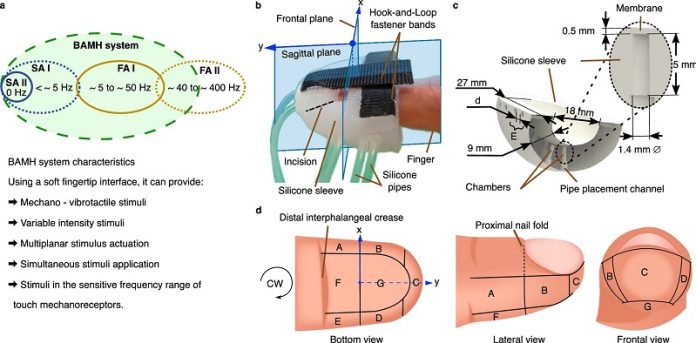
A new fingertip device developed by researchers at University College London (UCL) mimics the sensation of real touch, opening up exciting possibilities for medical diagnosis, virtual interactions, and even robotic surgery.
This cutting-edge technology, called the bioinspired haptic (BAMH) system, closely recreates the feeling of touching objects and can be used in many fields, from diagnosing loss of sensation to enhancing robotic tools used in delicate surgeries.
The study, published in Nature Communications, showcases the BAMH system’s ability to provide more natural and realistic touch feedback than current devices.
By stimulating the touch receptors in the skin, the system delivers a lifelike experience of interacting with real objects.
This development could lead to major improvements in diagnosing patients who have lost their sense of touch, as well as help surgeons regain the ability to feel while using robotic arms.
For example, diagnosing touch loss currently involves a doctor lightly brushing the patient’s skin with different weights and asking the patient if they can feel it.
The BAMH system could automate this process, speeding it up and providing more precise data, which could help doctors make better diagnoses.
“Our system could significantly improve the way touch sensitivity is measured by reducing the subjectivity in current methods,” said Professor Helge Wurdemann, one of the lead researchers at UCL.
The research team has received approval to start clinical trials to test the BAMH system in medical settings.
Beyond healthcare, the system could be a game-changer for robotic surgery. Surgeons often rely on their sense of touch to differentiate between healthy and cancerous tissues, but that tactile feedback is lost when they perform surgery using robotic arms.
The BAMH system could bring back some of that lost sensation, making robotic surgery safer and more effective.
One of the main reasons the BAMH system stands out is that it simulates how human touch works. Human fingertips have four different types of touch receptors, each responsible for detecting different things, like edges or textures.
The BAMH system uses tiny pulses to activate these receptors in a way that matches the natural sensitivity of the skin, creating a more realistic touch experience.
Dr. Sara Abad, another researcher on the project, explains that many existing touch devices are rigid and require users to undergo training to understand the sensations they feel.
“We wanted to develop a system that feels more natural and doesn’t require extensive training. By focusing on how human touch works, we’ve created technology that can be used in virtual interactions and medical diagnostics,” said Dr. Abad.
The team plans to showcase this new technology at the British Science Festival, where attendees will have the chance to feel the device’s realistic touch feedback.
This innovation could bring digital interactions closer to real life and open new doors in healthcare, robotics, and beyond.



